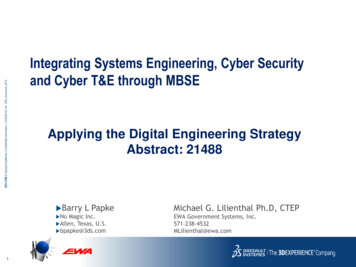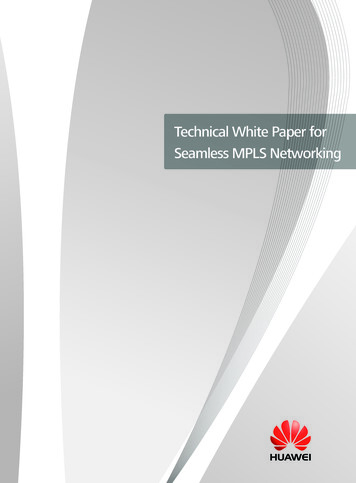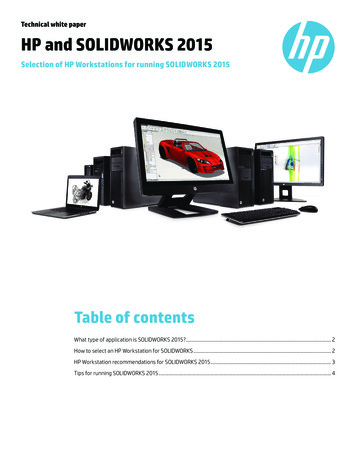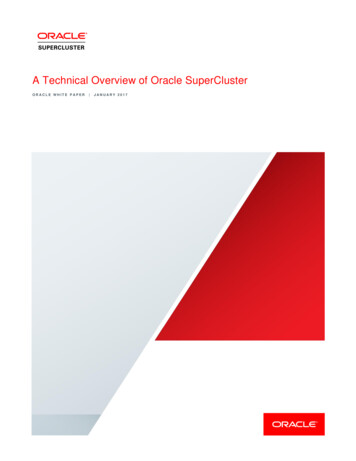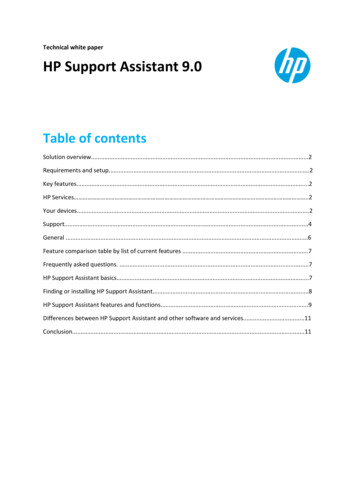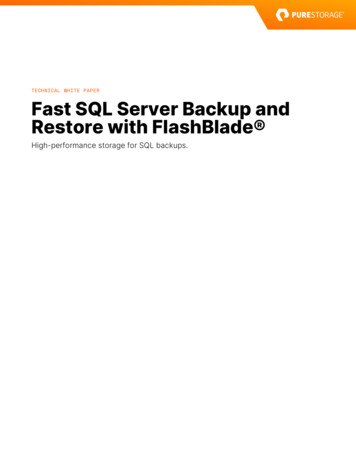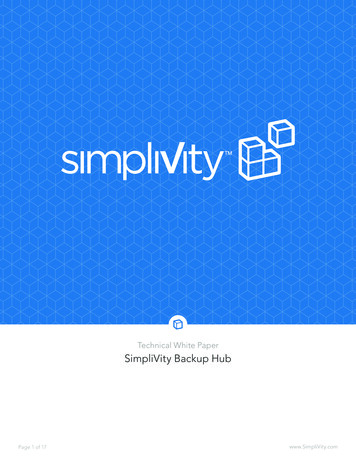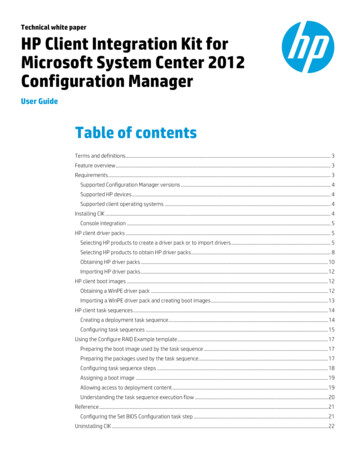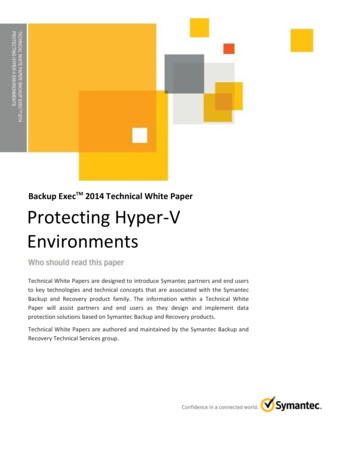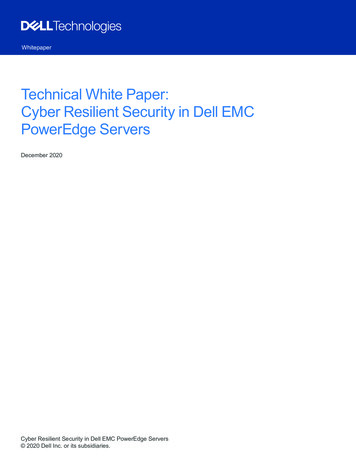
Transcription
WhitepaperTechnical White Paper:Cyber Resilient Security in Dell EMCPowerEdge ServersDecember 2020Cyber Resilient Security in Dell EMC PowerEdge Servers 2020 Dell Inc. or its subsidiaries.
RevisionsDateDescriptionJanuary 2018Initial releaseNovember 2020Revised versionThe information in this publication is provided “as is.” Dell Inc. makes no representations or warranties of any kind withrespect to the information in this publication, and specifically disclaims implied warranties of merchantability or fitnessfor a particular purpose.Use, copying, and distribution of any software described in this publication requires an applicable software license.Copyright 2018 Dell Inc. or its subsidiaries. All Rights Reserved. Dell, EMC, and other trademarks are trademarksof Dell Inc. or its subsidiaries. Other trademarks may be the property of their respective owners.Published in the USA [11/12/20] [Technical White Paper]The information is subject to change without notice.2 Cyber Resilient Security in Dell EMC PowerEdge Servers 2020 Dell Inc. or its subsidiaries.
Table of contentsRevisions.#1. Introduction.52. The Path to a Secure Server Infrastructure.62.1 Security Development Lifecycle.62.2 Cyber Resilient Architecture.72.3 Today’s Threats.73. Protect.83.1 Cryptographically-verified Trusted Booting.83.1.1 Silicon-based Root-of-Trust.83.1.2 BIOS Live Scanning.103.1.3 UEFI Secure Boot Customization.103.1.4 TPM Support.103.1.5 Security Certifications.103.2 User Access Security.113.2.1 RSA SecurID MFA.113.2.2 Simplified 2FA.113.2.3 SELinux framework.123.2.4 Least required privilege.123.2.5 Automatic Certificate enrollment and renewal.123.2.6 Factory Generated Default Password.133.2.7 Dynamic System Lockdown.133.2.8 Domain Isolation.133.3 Signed Firmware Updates.133.4 Encrypted Data Storage.143.4.1 iDRAC Credential Vault.143.4.2 Local Key Management (LKM).143.4.3 Secure Enterprise key Manager (SEKM).153.5 Hardware Security.153.5.1 Chassis Intrusion Alert.153.5.2 Dynamic USB Port Management.153.5.3 iDRAC Direct.163.5.4 iDRAC Connection View with Geolocation.163.6 Supply Chain Integrity and Security.163.6.1 Hardware and Software Integrity.173.6.2 Physical Security.173.6.3 Dell Technologies Secured Component Verification (SCV) for PowerEdge. 173 Cyber Resilient Security in Dell EMC PowerEdge Servers 2020 Dell Inc. or its subsidiaries.
Table of contents4. Detect.184.1 Comprehensive Monitoring via iDRAC.184.1.1 Lifecycle Log.184.1.2 Alerts.184.2 Drift Detection.195. Recover.205.1 Rapid Response to New Vulnerabilities.205.2 BIOS and OS Recovery.205.3 Firmware Rollback.215.4 Restoring Server Configuration after Hardware Servicing.215.4.1 Parts Replacement.215.4.2 Easy Restore (for Motherboard Replacement).225.5 System Erase.225.6 iDRAC9 Cipher Select.235.7 CNSA Support.235.8 Full Power Cycle.236. Summary.24A. Appendix: Further Reading.254 Cyber Resilient Security in Dell EMC PowerEdge Servers 2020 Dell Inc. or its subsidiaries.
Executive SummaryThe Dell Technologies approach to security is intrinsic in nature – it is built-in, not bolted-on after the fact, and it isintegrated into every step through Dell’s Secure Development Lifecycle. We strive to continuously evolve our PowerEdgesecurity controls, features and solutions to meet the ever-growing threat landscape, and we continue to anchor securitywith a Silicon Root of Trust. This paper details the security features built into in the PowerEdge Cyber Resilient Platform,many enabled by the Dell Remote Access Controller (iDRAC9). There are many new features added since the previousPowerEdge security whitepaper, which span from access control to data encryption to supply chain assurance. Theseinclude: Live BIOS scanning, UEFI Secure Boot Customization, RSA Secure ID MFA, Secure Enterprise Key Management(SEKM), Secured Component Verification (SCV), enhanced System Erase, Automatic Certificate Enrollment and Renewal,Cipher-Select and CNSA support. All features make extensive use of intelligence and automation to help you stay aheadof the threat curve, and to enable the scaling demanded by ever-expanding usage models.1. IntroductionAs the threat landscape evolves, IT and security professionals struggle to manage the risks to their data and resources.Data is being used across many devices, on premise, and in the cloud, and high impact data breaches continue to mount.Historically security emphasis has been placed on the OS, on applications, on firewalls and IPS and IDS systems. Theseall continue to be important areas to address. However, given the events of the past year or two that have shown threatsto hardware, we see just as critical a need to secure hardware-based infrastructure like firmware, BIOS, BMC and otherhardware protection, such as supply chain assurance.The Dell Technologies 2020 Digital Transformation Index found that data privacy and cybersecurity concerns are the No.1 barrier to digital transformation.1 63% of companies experienced a data compromise due to an exploited vulnerability2.Global damages related to cybercrime will reach 6 trillion in 20213.As servers become more critical in a software-defined datacenter architecture, server security becomes the foundationof overall enterprise security. Servers must emphasize security at both the hardware and firmware level by leveraging animmutable Root-of-Trust that can be used to verify subsequent operations within the server. This establishes a chain oftrust that extends throughout the server lifecycle, from deployment through maintenance to decommissioning.The 14th and 15th generation of Dell EMC PowerEdge servers with iDRAC9 deliver this chain of trust and combineit with security controls and comprehensive management tools to provide robust layers of security across hardwareand firmware. The result is a Cyber Resilient Architecture that extends across every aspect of the server, including theembedded server firmware, the data stored in the system, the operating system, peripheral devices, and the managementoperations within it. Organizations can build a process to protect their valuable server infrastructure and the data within it,detect any anomalies, breaches, or unauthorized operations, and recover from unintended or malicious events.1Dell Technologies 2020 Digital Transformation Index2Match Present-Day Security threats with BIOS-Level Control. A Forrester Consulting Thought Leadership Paper commissioned by Dell, 20193Ransomware Attacks Predicted to Occur. The National Law Review, 20205 Cyber Resilient Security in Dell EMC PowerEdge Servers 2020 Dell Inc. or its subsidiaries.
2. The Path to a Secure Server InfrastructureDell EMC PowerEdge servers have featured robust security for several generations, including the innovation of usingsilicon-based data security. Dell EMC 14G PowerEdge servers extended silicon-based security to authenticate BIOS andfirmware with a cryptographic Root-of-Trust during server boot process. Dell EMC product team considered several keyrequirements during the design of 14th and 15th generation of PowerEdge servers in response to security threats facedin modern IT environments: Protect: Protect server during every aspect of lifecycle, including BIOS, firmware, data, and physical hardware Detect: Detect malicious cyberattacks and unapproved changes; engage IT administrators proactively Recover: Recover BIOS, firmware, and OS to a known good state; securely retire or repurpose serversDell EMC PowerEdge servers conform to key industry standards on cryptography and security as elaborated throughoutthis paper, and perform on-going tracking and management of new vulnerabilities.Dell EMC has implemented the Security Development Lifecycle process with security as a key element in every aspectof development, procurement, manufacturing, shipping, and support resulting in a Cyber Resilient Architecture.2.1 Security Development LifecycleDelivering the Cyber Resilient Architecture requires securityawareness and discipline at each stage of development. Thisprocess is called the Security Development Lifecycle (SDL) model,in which security is not an afterthought but is rather an integralpart of the overall server design process. This design processencompasses a view of security needs throughout the entireserver lifecycle, as bulleted below and as shown in Figure 1: Features are conceived, designed, prototyped, implemented,set into production, deployed, and maintained, with security asa key priority Server firmware is designed to obstruct, oppose, and counterthe injection of malicious code during all phases of the productdevelopment lifecycle» Threat modeling and penetration testing coverage duringthe design process» Secure coding practices are applied at each stageof firmware development For critical technologies, external audits supplement the internalSDL process to ensure that firmware adheres to known securitybest ementationVerification/TestingFigure 1: Security Development Lifecycle of Dell EMC On-going testing and evaluation of new potential vulnerabilities using the latest security assessment tools Rapid response to critical Common Vulnerabilities and Exposures (CVEs) including recommended remediationmeasures if warranted.6 Cyber Resilient Security in Dell EMC PowerEdge Servers 2020 Dell Inc. or its subsidiaries.
2.2 Cyber Resilient ArchitectureDell EMC 14th and 15th generation PowerEdge servers feature an enhanced Cyber Resilient Architecture thatprovides a hardened server design to Protect, Detect, and Recover from cyberattacks. Some of the key aspectsof this architecture are: Effective Protection from attacks Reliable Detection of attacks» Silicon-based Root-of-Trust» Secure Boot» Signed Firmware Updates» Dynamic System Lockdown» Hard drive encryption andenterprise key management» Configuration and FirmwareDrift Detection Rapid Recovery with littleto no business interruption» Automated BIOS recovery» Persistent Event Logging» Rapid OS Recovery» Audit Logging and Alerts» Firmware Rollback» Chassis Intrusion Detection» Rapid System Erase2.3 Today’s ThreatsThere are many threat vectors in today’s changing landscape. Table 1 summarizes the Dell EMC approach to managingcritical backend threats.Table 1: How Dell EMC addresses common threat vectorsServer Platform LayersSecurity layerThreat vectorDell EMC solutionPhysical serverServer / component tamperingSecured Component Verification (SCV), ChassisIntrusion DetectionFirmware and softwareFirmware corruption, malware injectionSilicon-based Root of Trust; Intel Boot Guard;AMD Secure Root-of-Trust; UEFI Secure BootCustomizationCryptographically signed and validated firmware;SoftwareCVE reporting; Patching as requiredAttestation trust featuresServer identity spoofingTPM, TXT, Chain of trustServer managementRogue configuration and updates, unauthorizedopen-port attacksiDRAC9. Remote attestation,Server Environment LayersSecurity layerThreat vectorDell EMC solutionDataData breachSED (Self Encrypting Drives) – FIPS or Opal/TCGSecure Enterprise Key Management ISE-only(Instant Secure Erase) drivesSecure User AuthenticationSupply Chain IntegritySupply Chain SecurityCounterfeit componentsISO9001 certification for all global servermanufacturing sites; Secured ComponentVerification; proof of possessionMalware ThreatsSecurity measures implemented as part of SecureDevelopment Lifecycle (SDL) processPhysical security in Manufacturing sitesTransported Asset Protection Association(TAPA) facility security requirementsTheft and tempering during transportCustoms-Trade Partnership Against Terrorism(C-TPAT); SCV7 Cyber Resilient Security in Dell EMC PowerEdge Servers 2020 Dell Inc. or its subsidiaries.
3. ProtectThe “protect” function is a key component of the NIST Cybersecurity Framework and serves to guard againstcybersecurity attacks. This function consists of several categories including access control, data security, maintenance,and protective technology. The key underlying philosophy is that infrastructure assets must provide robust protectionagainst unauthorized access to resources and data as part of a comprehensive secure installation and computingenvironment. This includes protecting against unauthorized modifications of critical components such as BIOS andfirmware. The platform meets the current recommendations in NIST SP 800-193.The Cyber Resilient Architecture in PowerEdge servers offers a high level of platform protection that includesthe following capabilities: Cryptographically-verified Trusted Booting User Access Security Signed Firmware Updates Encrypted Data Storage Physical Security Supply Chain Integrity and Security3.1 Cryptographically-verified Trusted BootingOne of the most critical aspects of server security is ensuring that the boot process can be verified as secure.This process provides a trusted anchor for all subsequent operations such as booting an OS or updating firmware.PowerEdge servers have used silicon-based security for several generations for features such as
Dell EMC PowerEdge servers conform to key industry standards on cryptography and security as elaborated throughout this paper, and perform on-going tracking and management of new vulnerabilities. Dell EMC has implemented the Se

